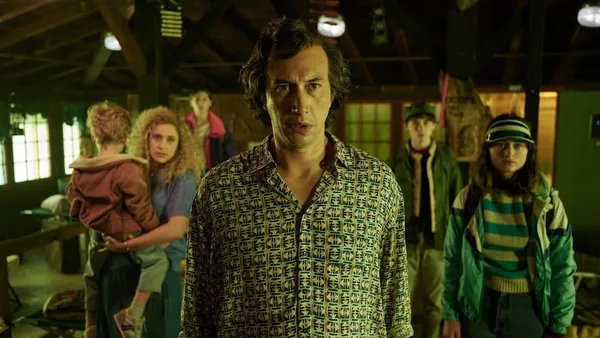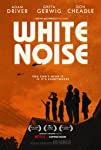Eye For Film >> Movies >> White Noise (2022) Film Review
White Noise
Reviewed by: Anne-Katrin Titze

Noah Baumbach has a firm grip on Don DeLillo’s masterpiece White Noise (the Opening Night selection of the 60th New York Film Festival). It is the first time the writer/director adapted someone else’s work, and the result is a vibrantly disturbing tableau that is joyously faithful to the source.
The Gladney household consists of Jack (Adam Driver) and his wife Babette (Greta Gerwig), his two children from previous marriages, Heinrich (Sam Nivola) and Steffie (May Nivola), Babette’s daughter Denise (Raffey Cassidy) and the wise, wordless Wilder (played by twins Henry Moore and Dean Moore), who, as opposed to the novel, is the son they have together (Wilder here also does get to say one single show-stopping word - “again”).

Cinema has visual and musical forms of expression at its disposal that books don’t. Baumbach, together with his expert crackerjack team, cinematographer Lol Crawley, production designer Jess Gonchor, costume designer Ann Roth, composer Danny Elfman, and the James Murphy led LCD Soundsystem and of course the actors, creates the effect of heightened reality in a multitude of ways. You can flee the bombardment of words, as the family tends to speak all at once, by inspecting the bright cornflake boxes and juice cartons, and Sprite cans. In order not to think that all of this one day will end for all of us.
In the novel, DeLillo uses the mythical quality of rhythms created by listing items in clusters of three. “Natural, whole-milk, low fat” or “Weejuns, Wallabies, Hush Puppies” read as incantations. “Coke is it, Coke is it, Coke is it” - the rhythm is what creates the texture of a never-ending cumulative tale of eternal renewal.
During a stroll in the supermarket, Jack Gladney, founder and chair of the department of Hitler Studies at a small Middle-American college, introduces Babette to his colleague Murray Jay Siskind (Don Cheadle), whose specialties include movie car crashes and Elvis and many other fascinating subjects. In Don DeLillo’s novel, Murray on that occasion utters the following pivotal sentences which inform the orbit of the film: “Here we don’t die, we shop. But the difference is less marked than you think.” He also comments on Babette’s “important hair,” which Gerwig sports with arrant aplomb.
“Okay - roll film!” These are the first, rather comforting words we hear at the start, while being plunged into Murray’s car crash montage lecture that speaks of American optimism. Once you see beyond the violence, the car crash is as American a celebration as Thanksgiving and the Fourth of July, he declares. Foreign movies simply can’t compete.
It is welcome day at the College-on-the-Hill and the station wagons are lining up, dropping off students with their TV sets and lacrosse sticks. This sequence is the first of many feats by the marvellously erudite and playful Ann Roth, whose costumes mingle fantasy and reality with sangfroid. The hacking jackets and the crisp moms in cable-knit cardigans and plaid, providing their offspring with last-minute instructions on how to properly tie a sweater around the neck - they all look less as though they were actual college students and parents from the 1980s, and more like a colourful display, an undying diorama of anticipation come alive. A cyclical ritual acting the promises of a shiny college future.
When Denise finds a container of a medication called Dylar in the trash at home, she connects it to the books on the occult her mother had hidden in the attic, and Babette’s more and more frequent memory problems.
Jack, whose academic nom de plume spelling is J.A.K. (to add substance and gravitas), lectures on Hitler paraphernalia and, to remedy his guilty secret that he doesn’t speak German, furtively studies the language with a tutor to prepare for the big international Hitler conference his department will be hosting soon. He is at the skill level of “Tomorrow is Tuesday” and “I eat potato salad.” Adam Driver has a field day with the pronunciations. Babette’s momentary out-of-house occupations consist of reading tabloids to old and blind people and giving evening classes on subjects such as “Sitting and Standing” or the upcoming course “Eating and Drinking.”
When an accident produces a black billowy cloud, soon to be upgraded to “Airborne Toxic Event” by the media, the family priorities become scrambled anew. Baumbach intercuts, for what is called chapter two in both novel and film, the truck with flammable load en route to disaster with Jack and his illustrious colleagues first in the faculty cafeteria and later at the great duelling lecture he conceptualized with Murray on biographical tidbits around Hitler and Elvis.
The students, wearing an assembly of the most garish trends of the Eighties look like M&Ms and Sour Patch Kids, and Jelly Beans, while Jack, wrapped in his black academic robe resembles a raven that, when he gets in position by a window sill, turns into Mephistopheles out of Murnau’s silent classic Faust from 1926. Adam Driver suddenly channels more than Emil Jannings’s demon and performs Death himself, while elaborating on the word from Old English, Old German, Norse. The future dead of the past who came “to be a crowd” alternate with the toxic crash in the film’s present.
Baumbach shoots his disaster scenes, evacuations, and poisonous cloud rife with contradictions. The purple sky of doom is beautiful and strangely soothing. The humour in the shots of people fleeing in their cars is not flatly cynical, but strangely life-affirming and absurd in its realness, or real in its absurdity. A rescue centre in a Chinese restaurant can seem cosy, while at home harmless vegetables, the pungent green beans, the solar cornbread, and the apocalyptically orange carrots seem to signal worrying days ahead.
The kids begin to have symptoms they heard on the radio. Or did they have them already before? One of the symptoms is a sense of déjà-vu. Audience members who read the novel can relate. The dialogue is often taken verbatim from DeLillo, reshuffled and spoken in a tone of slight detachment, as though the actors were realizing while speaking that they had said the same thing before. Baumbach bets on the uncanny effect this has. Murray interprets it as a sort of amnesia. It all did happen before, we only forgot. “Like you I forgot” says Emmanuelle Riva’s character in Alain Resnais’s Hiroshima Mon Amour.
The rain and flooding in White Noise eerily mirrors the footage of the destruction in Florida by Hurricane Ian, that we all at the New York Film Festival premiere had watched on television that same day. The remnants of the storm that travelled north are pounding on my window as I write.
The Shell logo at the gas station in the movie looks like the gates of hell. Coping mechanisms don’t work anymore as things unravel. The children continue to talk non-stop. The family is the cradle of the world, and of misinformation. Jack used to tell Murray about Albert Speer and the “law of ruins,” architecture that would decay in a glamorous way. “Hitler can’t protect you,” says Murray and maybe “you can kill death.” Cheadle plays Murray as very human and less gargantuan than I imagined the man with the outrageous theories to be.
A puppet show is staged of the event going on outside. To fear or not to fear? SIMUVAC is forced to rehearse the simulation with the real event. The total unpreparedness diagnosed by DeLillo in 1984 is as pertinent as ever. Part three, Dylarama, deals with the aftermath and unveils the secret of Babette’s mysterious pills, which Jack has checked out by one of his colleagues, the brilliant scientist Winnie Richards (Jodie Turner-Smith). A composite called Mr. Grey (Lars Eidinger) turns flesh and blood and may suffer from a side effect that makes it impossible to distinguish words from things.
Husband and wife keep competing over who is more obsessed with death. Before all comes to a close, more Teutonic winds blow the plot around. At the long awaited Hitler conference, the music choice is of subtle brilliance. The instrumental tune is called “Muss I Denn,” an old German folksong, famously sung by Elvis Presley in German, wearing military uniform.
Eidinger in a motel room gives a performance of physical slapstick, featuring out-of-control bodily functions. In movies this year it is only rivalled by what Sunnyi Melles does in Ruben Ostlund’s Triangle Of Sadness. Another Germanic touch in White Noise comes from Barbara Sukowa as a nun, her garments the perfect counterbalance to Driver’s academic devil raven cape. “Hell is when no one believes,” she says. The world is dependent on the belief that someone does believe, even if it is all just pretence.
The uproarious finale, an all-encompassing supermarket dance number, visually part Stepford Wives and Jacques Demy musical, is set to new body rhumba, a new song by LCD Soundsystem, all ready to show the Grim Reaper what we humans are up to.
Reviewed on: 04 Oct 2022
















